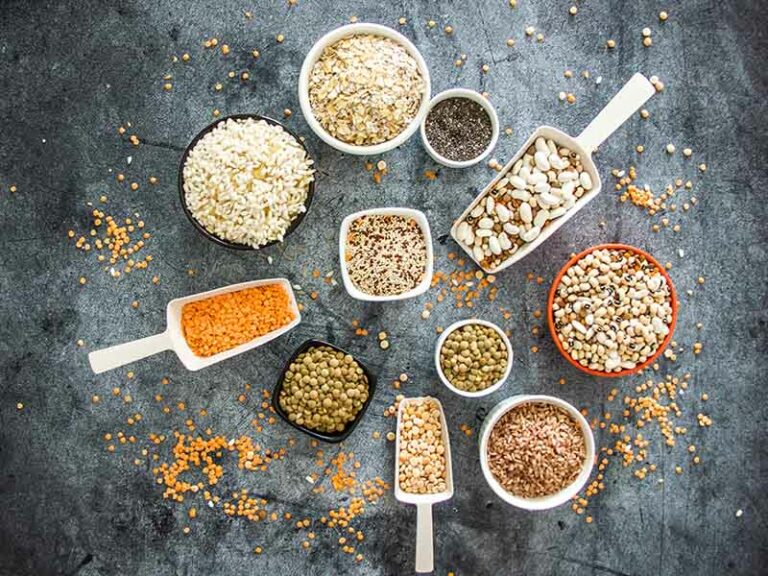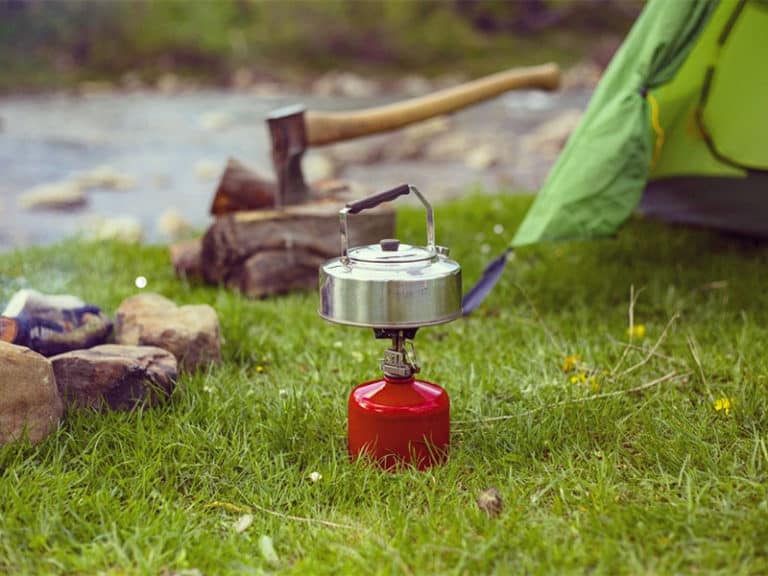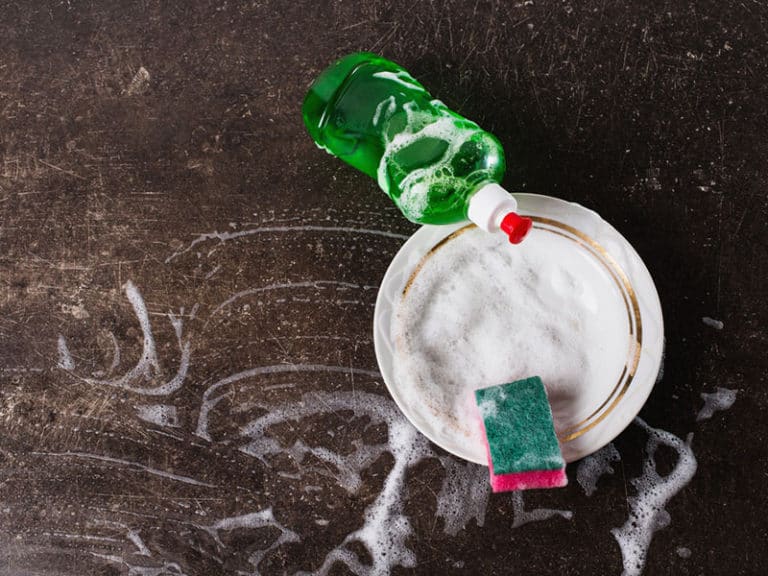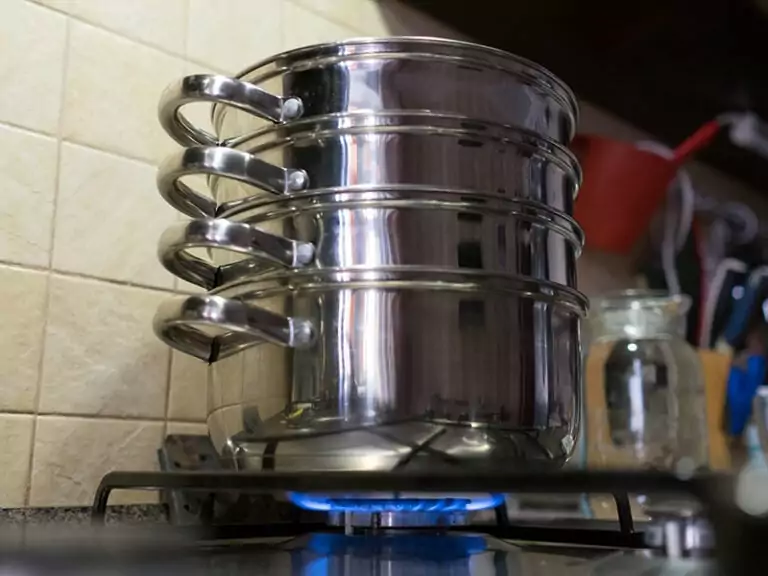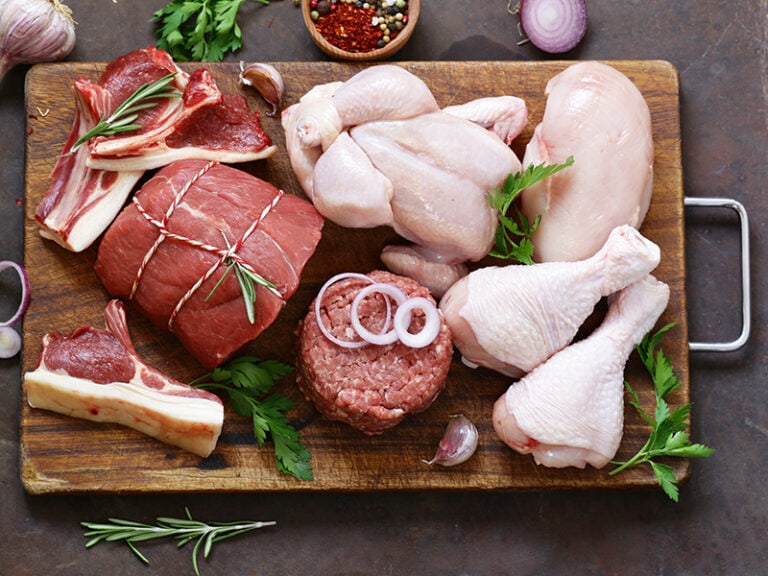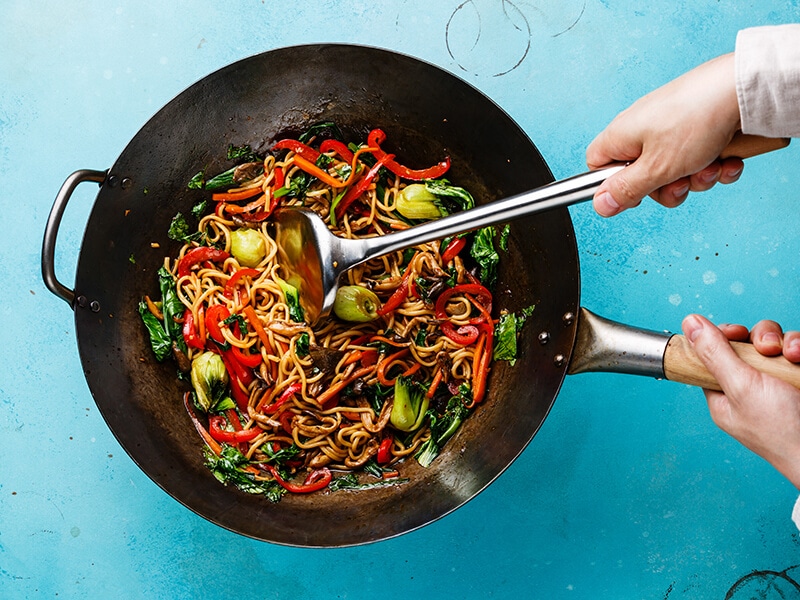
Have you ever wondered which types of woks you should choose? If the answer is “yes”, there is nothing to be embarrassed about. Since there are numerous varieties, considering each type of wok is undoubtedly a daunting task.
In several cases, you may end up with an undesirable one. Thus, it can impact your cooking experience and mood in some bad ways. For this reason, this article covers solely the most popular woks, so you only choose from the best ones. Let’s jump in!
What Is A Wok?
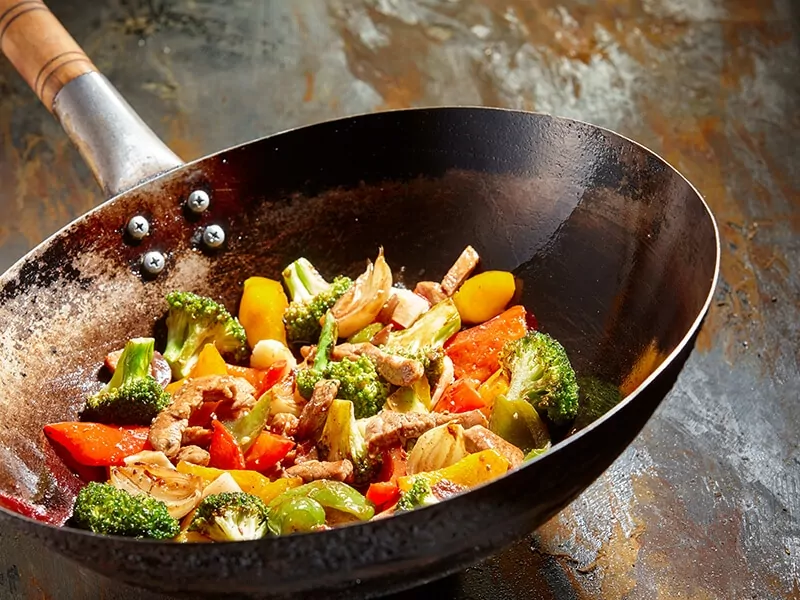
A wok is a longtime cooking item, dating back to 2000 years ago in China (1). It has a round bottom, high sides, and either one or two side handles.
This cookware is popular not only in China but also in other parts of the world, particularly in East Asia and Southeast Asia. Therefore, there is no surprise about its vital role in Asian food. Due to their versatility, woks can handle a variety of dishes.
Some common cooking methods of this cookware include: stir-frying, steaming, boiling, braising, searing, pan-frying, deep frying, smoking, and stewing. A wok’s round bottom allows it to heat up evenly, which saves you some cooking time.
Tossing food is also easy and convenient due to its high sides. This is a great bonus for stir-frying because you can mix ingredients thoroughly and cook them uniformly. A spatula and ladle are great tools to help you toss and pick up food from a wok.
In some cases, you may need a wok lid or wok ring for steaming or boiling. These accessories enable your cookware to stand still on a cooktop during cooking.
Find out how carbon steel woks are made by hand with this amazing video.
3 Common Types of Wok Based On Styles
In terms of styles, woks can be classified as Cantonese, Mandarin, and electric woks. For a quick glance, check the table below.
1. Cantonese Woks
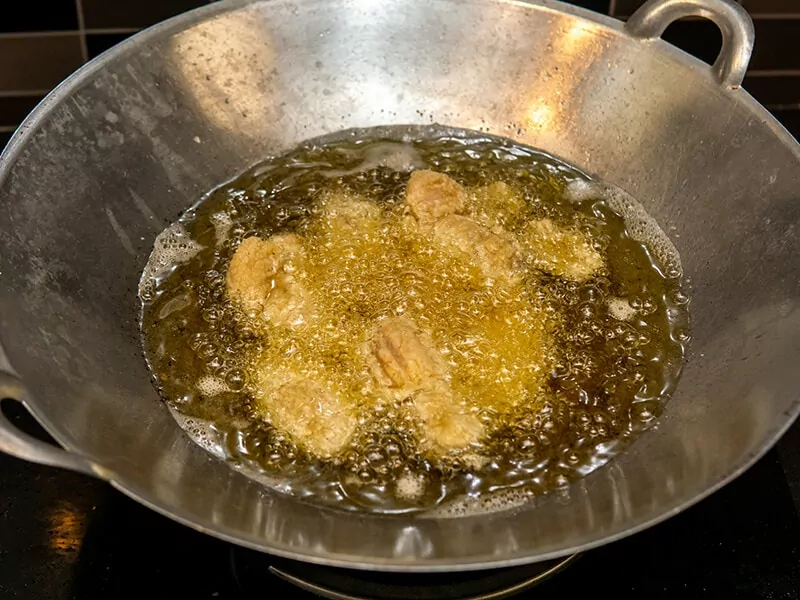
Cantonese woks come with 2 U-shaped handles on each side. They are shallower than their Mandarin cousins. These designs make Cantonese woks suitable for serving large quantities of meals but not shaking ingredients.
Instead, you can stir foods while your cookware remains stationary on a stove. Kitchen tools, like a spatula and paddle, will help you cook much more conveniently. If you often prepare boiled, braised, and deep-fried dishes, this wok style should be your choice.
2. Mandarin Woks
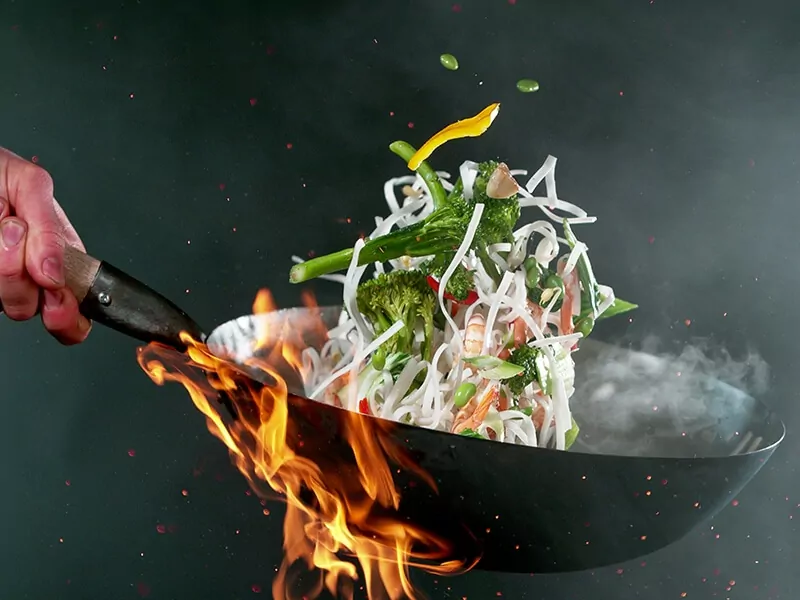
Mandarin woks have round bottoms and a single long handle. Their handles are often made from wood or metal. Sometimes, they can also be equipped with a loop handle on the other side to help lift and add grip.
Unlike their counterparts, Mandarin woks are excellent for tossing foods. A long handle along with a deeper base helps you shake your cookware more comfortably, especially when stir-frying. Dividing dishes into smaller servings is also easy with these woks.
3. Electric Woks
Electric woks are bowl-shaped cooking items. They often have 2 handles, but certain products can come with a single handle. Their construction consists of a built-in heating element and a cord to plug in socket outlets.
Unlike Cantonese and Mandarin varieties, electric woks don’t use gas or stove burners but electricity. This means you can use your modern cookware almost everywhere, from dining tables to hotel rooms.
Cooking with electric woks also doesn’t require much oil. Despite their convenience, these cooking items may not reach high enough heat for certain recipes, like stir-fried dishes. Besides, electric woks often cost more than traditional varieties.
5 Common Types Of Wok Based On Materials
Woks are divided into various kinds based on their materials. However, there are only five varieties you should consider when choosing a wok. For a summary, look at the table below.
1. Carbon Steel Wok
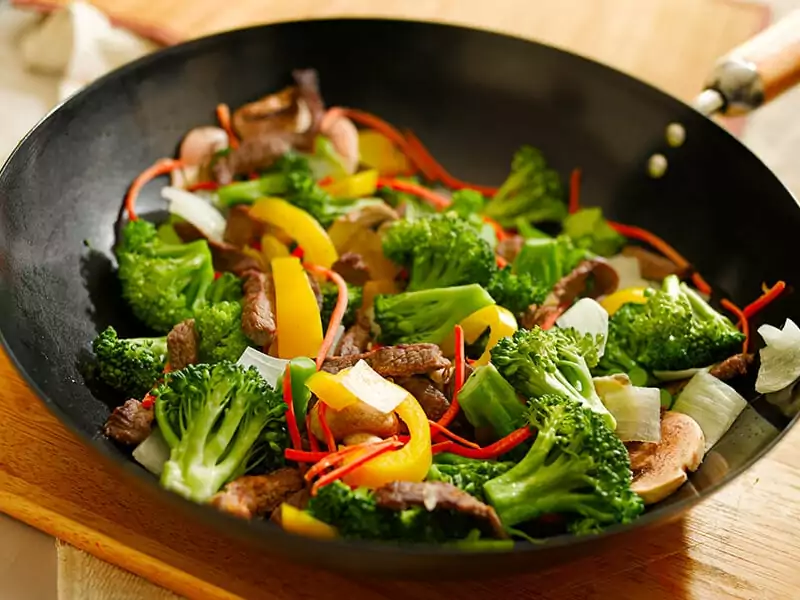
A carbon steel wok is the first mentioned because of its extreme popularity. There are several reasons why numerous Chinese restaurants love it. This cooking item is not only cheaper but also lighter than its cast iron counterpart.
On top of that, a carbon steel wok can heat up rapidly and evenly, making it ideal for many stir-fried dishes. Due to its magnetic property, this durable cookware is also compatible with induction cooktops.
When you use a carbon steel wok, seasoning is necessary to give it a natural nonstick coating. To season your wok, you will need to heat up the oil on the cookware until it pasts the smoke point and creates a bioplastic layer(3).
This seasoned surface doesn’t only prevent food from sticking to your wok but also protects it from rust. Although both carbon steel and cast iron woks require seasoning, the former is more difficult to process than the latter.
While carbon steel woks often come at affordable prices, certain products can be pricey. The highest-quality ones are often hand-made and made from heavy gauge steel. By contrast, lower-quality woks are cheaper but deform or misshapen more easily.
Season your carbon steel wok with this comprehensive instruction.
2. Cast Iron Wok
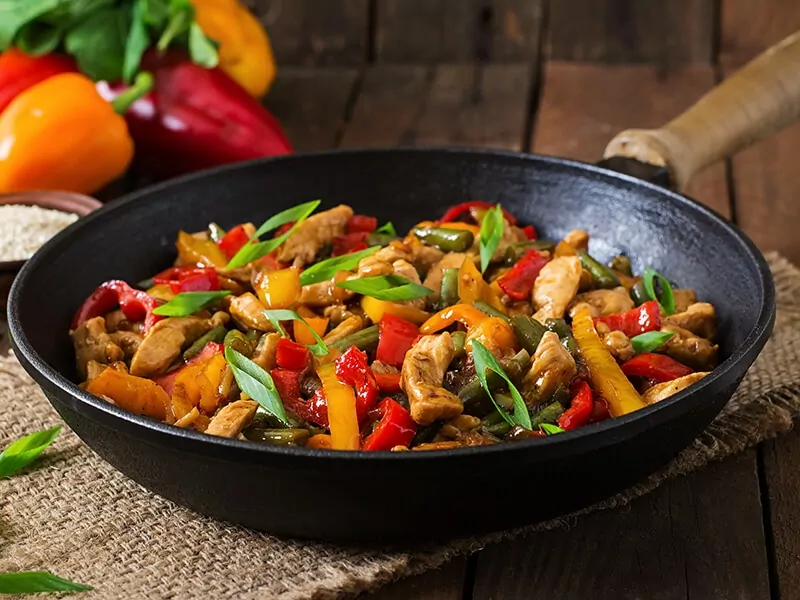
A cast iron wok is a popular cookware in numerous China households. It typically comes with 2 small metal handles on each side. Since it’s made from cast iron, this wok is resistant to extremely high heat, warping, and bending.
Due to its heaviness and thickness, this cooking item heats up more slowly but retains heat better than other varieties. Because this material takes more time to cool down, it may cause your food to be burned or overcooked.
For this reason, you should remember to take your food out of it as soon as you finish cooking. However, when this cookware handles large volumes of liquids or vegetables, it will cool down more quickly than usual. This means it needs a while to heat up again.
Lifting and shaking a wok can also be difficult because of its heavy weight. As a result, a cast iron wok may not be the best for stir-frying.
Aside from regular cast iron woks, there are also light cast iron varieties. These alternatives are lighter and cheaper but also less durable. Although they heat up faster, they also retain heat poorly than traditional woks.
Seasoning is a must when using this kind of wok. Otherwise, it can be easy to rust if not maintained properly. Compared to its carbon steel cousin, this variety is easier to create a nonstick coating, which also works more effectively.
3. Stainless Steel Wok
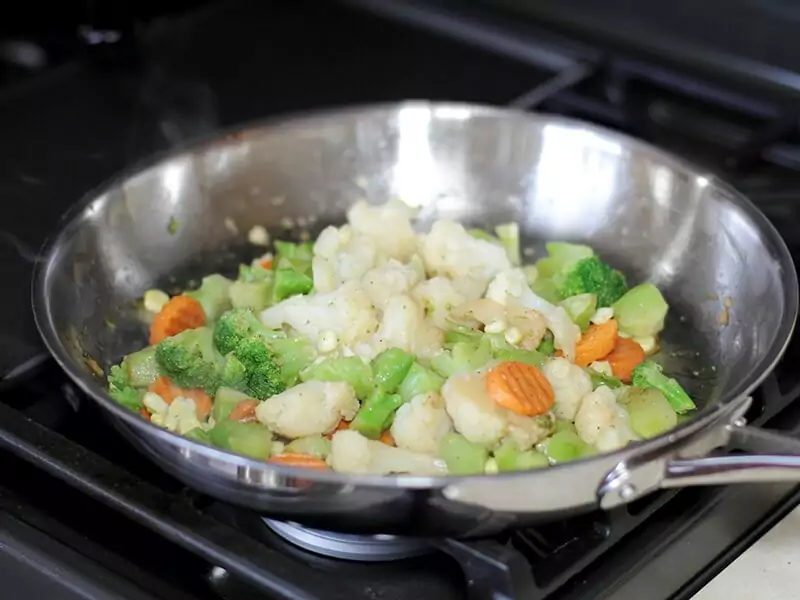
As the name suggests, a stainless steel wok doesn’t rust easily. Unlike carbon steel and cast iron varieties, this type of wok doesn’t need to be seasoned. Thanks to its smooth surface, cleaning a stainless steel wok is simple and convenient.
All you need to do is to wash and wipe it dry after each use. However, food can still stick to it after cooking because this variety doesn’t have a seasoned surface. Heating oil or fat until it’s hot enough before handling food will help you avoid that disaster.
A stainless steel wok is made from a non-reactive material. You can use it to prepare dishes involving vinegary or acidic foods. Due to its high heat resistance, this wok is also compatible with an oven. Just ensure your cookware’s handle is metal as well.
In addition, a stainless steel wok is lighter and heats up more rapidly than its cast iron counterpart. Although it can help you cook faster, burning food may occur easily if you don’t pay enough attention. Moreover, cleaning a burned wok can be really tough.
Preparing steamed dishes is a great way to take advantage of this cookware. It will not rust while steaming for a long time. A glass lid allows you to easily observe your food during cooking. Besides, a stainless steel wok is also perfect for stewing and braising.
4. Aluminum Wok
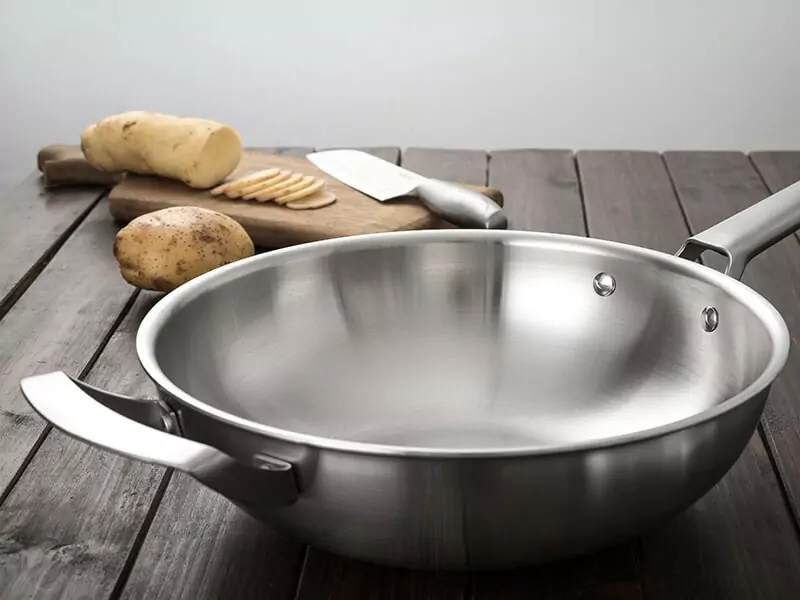
An aluminum wok is the lightest on the list. You should give it a try if you find those materials mentioned above still quite heavy. This cookware is easy to lift or shake during cooking.
In addition, it is also well-known for its impressive heating conduction and distribution. An aluminum wok can heat up quickly and evenly. These properties benefit several cooking methods, particularly stir-frying and deep frying.
However, an aluminum wok is a reactive cooking item. You should avoid using it with recipes involving vinegar and acidic foods. Otherwise, it can leach the metal into your dishes. Although aluminum is safe to consume, it may impact the taste of your foods.
Aluminum is often not as hard as other materials. As a result, it can be prone to high temperatures and warping compared to its counterparts. But its affordability is a bonus for your budget. Besides, it’s also easy to clean with soap and water or a dishwasher.
5. Cast Aluminum Wok
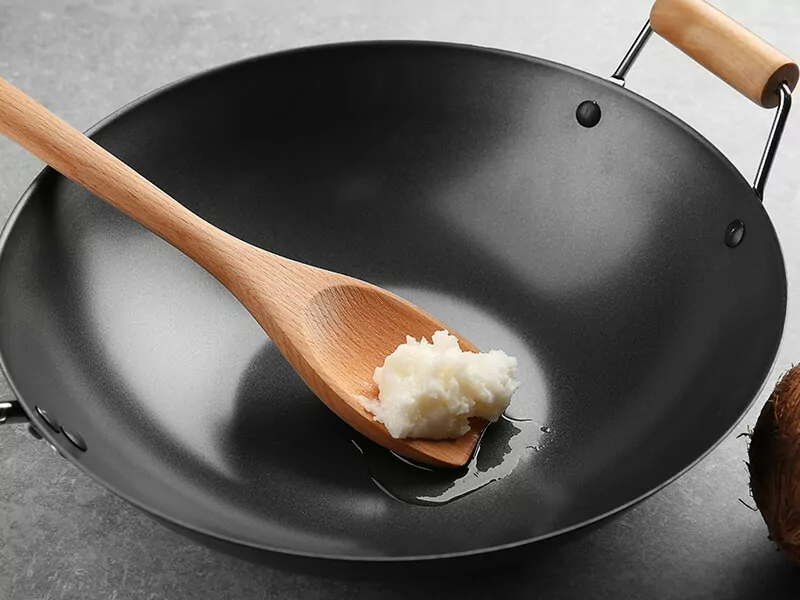
A cast aluminum wok is often compared with a cast iron wok in terms of heat conduction and retention. Both take a while to heat up and keep heat well. However, a cast aluminum variety gets hot faster.
It’s also lighter and cheaper than its cast iron counterpart. While a cast aluminum wok doesn’t rust, it also requires seasoning. Although it takes more time to season, this method maintains its color and makes it easier to clean.
Like its aluminum cousin, a cast aluminum wok is reactive cookware. It can leach the metal into your vinegar or acidic foods during cooking. But this cookware is sturdier and can bear high temperatures. Therefore, you can put it in an oven safely.
6. Different Factors To Choose A Wok
You already know the pros and cons of the five types of woks. However, there are still other factors you should consider. This section will help you select a suitable wok for various aspects.
1. Material
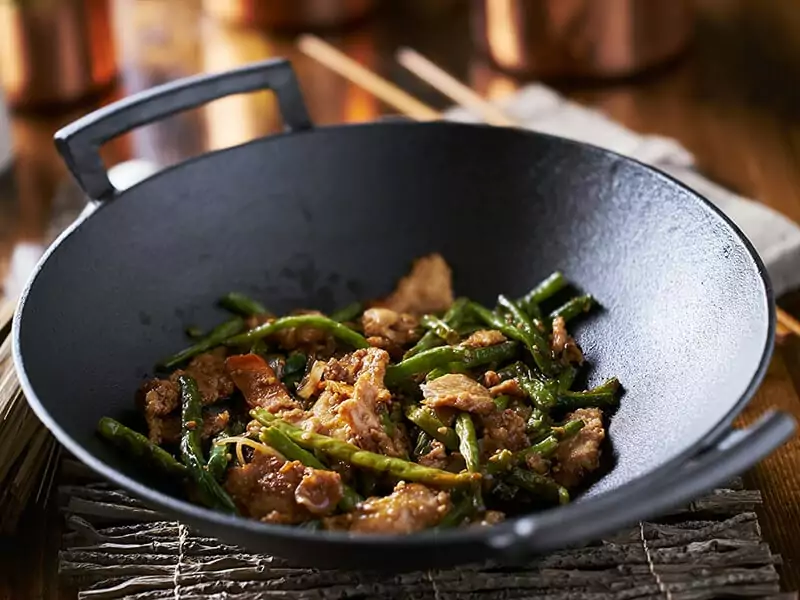
Woks vary from material and material. This means each variety comes with various properties. Understanding the pros and cons of each cookware material helps you decide more accurately.
For example, carbon steel is durable and heats up more quickly and evenly, whereas cast iron takes more time to heat but retains heat better. Carbon steel is lightweight and naturally convenient to clean, while cast iron is heavy and easy to rust.
2. Nonstick Coating
Many woks are made with nonstick coatings, whereas others are not. Deciding whether your cookware is nonstick or not can impact your cooking experience. On the one hand, picking up food from a nonstick wok and cleaning it are much easier and less daunting.
On the other hand, most nonstick coatings are quite fragile and deteriorate over time. For example, Teflon coatings can’t bear temperatures of over 500°F (260°C)(2). This means nonstick woks will not be suitable for stir-frying and high-heat cooking.
3. Handles
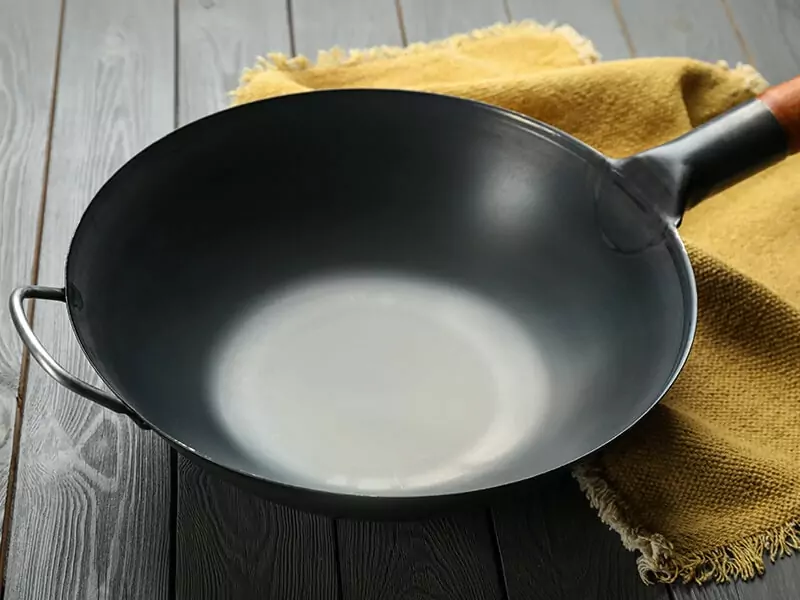
Woks can come with either one or two handles. The number of them plays a key role in cooking performance. In case you rely on moving cookware and tossing ingredients, especially during stir-frying, a wok with a single long handle is an excellent choice.
Along with this handle, there is usually a smaller one on the other side to help you lift it during cooking. However, if you don’t shake or toss foods frequently, two small metal handles on each side should be a way to go.
4. Round Bottom Vs. Flat Bottom
While woks are well-known for their round bottoms, there are others with flat bottoms as well. This is because a round-bottom wok’s design makes it not ideal to use with an electric stove. Instead, it may reflect heat and damage your cooktop.
For this kind of stove, a flat bottom wok will be a better option. This variety is more compatible and conducts heat better than its traditional counterpart. However, the latter performs perfectly when it comes to a gas hob or traditional fire pit.
5. A Wok With A Lid
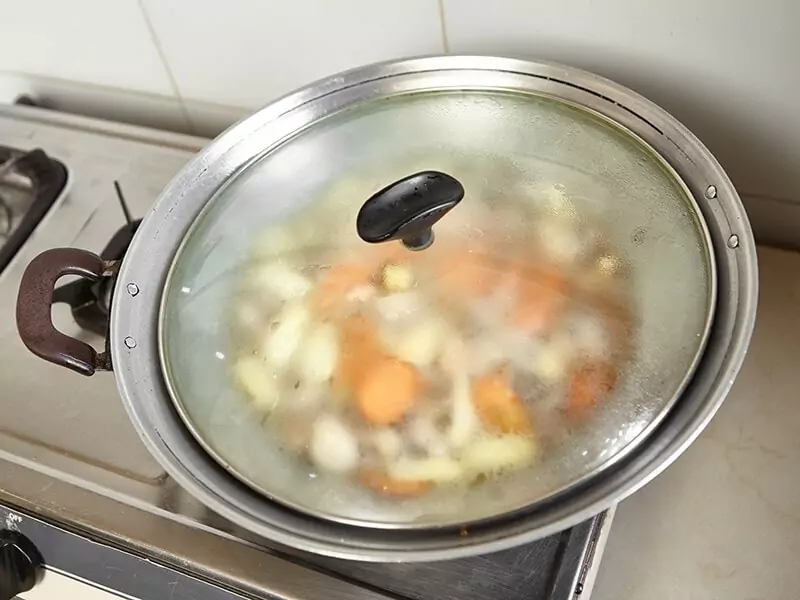
Many woks don’t often come with lids. But there are some advantages to buying one with a lid. Covering a wok with a lid during cooking benefits a variety of dishes, especially Chinese cuisine.
Steaming, braising, and stewing can also take the most out of this approach. If you use a glass lid, you can also keep an eye on the food inside. Meanwhile, stainless steel and wood varieties are more durable.
6. Size
Depending on your household and cooktop sizes, you may have various suitable options. Chinese woks often range between 13-14 inches, while the figures for US woks tend to be 10-20 inches.
A 14-inch wok is a no-brainer for a family of 2-5 people. Meanwhile, a household of 1-2 members can go with a smaller wok. Due to its size, lifting and tilting it are much easier compared to larger ones.
However, larger cookware will handle more food quantities. It’s also spacious enough to stir and toss ingredients more comfortably. But using a big wok for preparing small amounts of food may burn your food and make it bitter.
Other Accessories To Use With A Wok
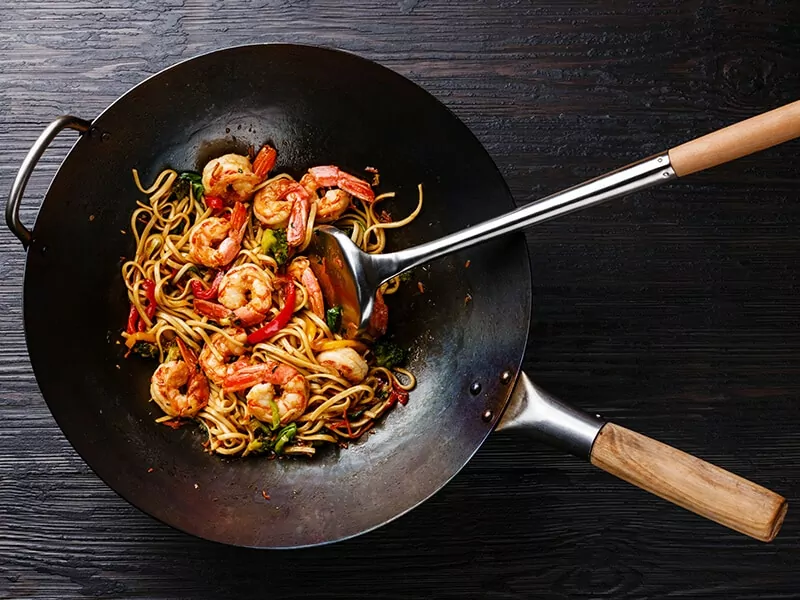
Although woks are versatile cooking items, you can consider buying their additional accessories to boost your cooking performance. Below are some options you can consider.
- A wok burner is a powerful appliance for woks. It enables your cookware to heat up in no time. Therefore, it will benefit some cooking methods, like searing, stir-frying, deep drying, and smoking.
- A wok ring ensures a round bottom wok is stable on various kinds of cooktops, like electric stoves. It can also concentrate heat and protect your cookware from tearing. However, using a wok ring is not necessary for a flat bottom wok.
- A wok spatula and ladle are long handles designed to use with large woks. These accessories allow you to toss, flip, and pick up large food quantities. When it comes to liquids, a wok ladle can handle them well.
- A wok brush is a necessary tool for carbon steel and cast iron woks. It helps you clean your cooking items without damaging their seasoned surface. Removing food bits with a wok brush also doesn’t cause scratching or scraping.
How To Clean A Wok (Step-By-Step)
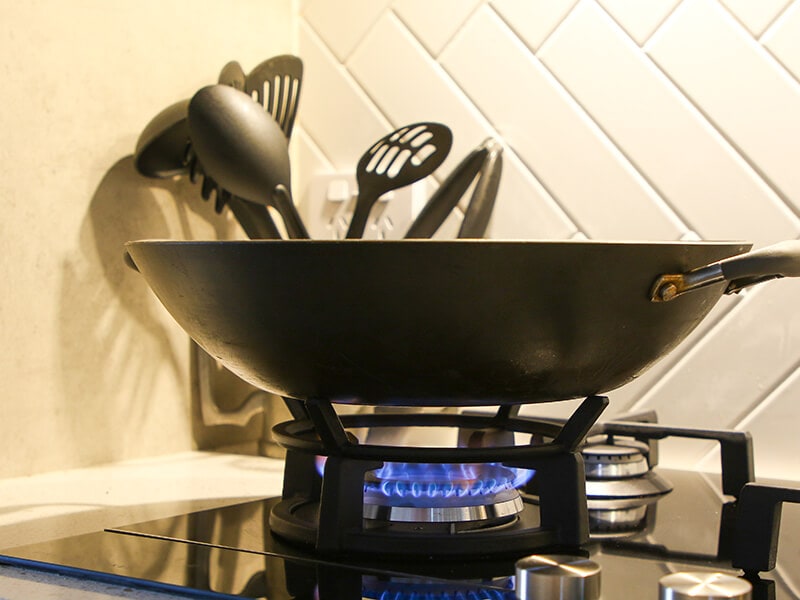
Choosing a perfect wok can be tricky, but cleaning it may be even more challenging. Below are some steps to help you take care of your cookware properly.
- Let your wok cool down before washing.
- Run it under warm or hot water.
- Gently scrub food bits with a sponge, scouring pad, or wok brush.
- Completely dry your wok with a kitchen towel after rinsing.
- Heat your wok at medium-high heat until all water evaporates entirely.
- Apply a minimal oil amount and wipe it with a paper towel (this step is necessary if you don’t use your wok often).
If your wok is rusty, check this video out to rescue it properly.
FAQs
While these sections above cover almost everything about types of woks, there are still other questions you may want to ask. Make sure you give these questions a thorough read to wrap up the article.
Choose A Wok That Suits Your Needs Best!
The five kinds of woks mentioned are all deserved in your kitchen. While you can’t go wrong with any of them, it’s understandable to choose your cookware meticulously. If you love stir-fried dishes, carbon steel and aluminum woks should be the best.
Meanwhile, a stainless steel variety is a go-to for steaming, braising, and stewing. For simmering, a wok made from cast iron can really shine. And a cast aluminum wok will be an excellent alternative to its cast iron counterpart.
Are there other things you would like to know about? Share the post and let me know in the comments.
References
- Olver, L. (no date) The food timeline: History notes–Asian-American cuisine.
- Safety of Teflon™ nonstick coatings (no date) Teflon.
- Seasoning (cookware) (2022) Wikipedia. Wikimedia Foundation.

